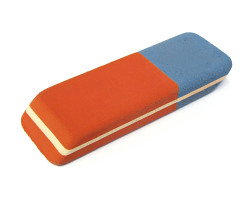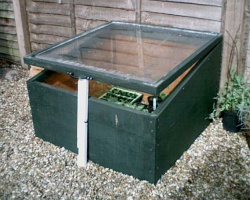 We’ve had an email from Chrissy asking what to do with an old doormat:
We’ve had an email from Chrissy asking what to do with an old doormat:
The bristly kind. Compost it?
The bristly ones are usually made from coir – coconut fibre – so a natural material that will compost — but it can apparently takes many years to decompose. That’s a good thing really – we’d have to replace our doormats more often if they rotted every six months – and it probably would rot down quicker in a warm, moist compost bin than on the doorstep, but possibly one for a long term compost bin rather than a quick turn around one. (Also, be careful if it has rubber or synthetic backing – you might not want that breaking down in your compost bin at all.)
In her short and sweet email, Chrissy doesn’t say why she’s getting rid of it but depending on its condition, it might be reusable in the same or another capacity – if I had a spare doormat right now, no matter how tatty, it would go outside the door to our chicken run so I could wipe my feet on the way out before traipsing back up the garden. Or, I made a wellie stand a few weeks ago and it could easily be fitted out with some stripes of bristly coir to help clean the mud off them first.
Any other reuse suggestions?
Categories: garden, household, items
Posted by louisa
on 2 July 2010
 (A companion post to the one last October – super tips for reducing energy usage/heating bills in the winter!)
(A companion post to the one last October – super tips for reducing energy usage/heating bills in the winter!)
After a few false starts, summer is definitely here in the UK now and it’s the warmest it’s been for a few years (although that’s not saying much really). We’re not really equipped for very hot or very cold weather – because until we started messing with the climate, we didn’t regularly get either – but air con is now de rigueur in new workplaces and play places – offices, shops, cinemas etc. People are also increasingly buying small air con units for their homes but generally more people just run fans to keep air circulating — both of which, of course, use electric juice.
How do you keep yourself and your home/office cool? What are your favourite super tips for keeping cool without using a lot of energy or water? I’m expecting that everyone knows to stay well-hydrated and not wear thick woolly jumpers/scarves in the midday heat – but what else do you do?
Categories: reduce this
Posted by louisa
on 1 July 2010
 We’ve had an email from Sophie:
We’ve had an email from Sophie:
I bought a big bag of rubbers at the start of school but they were hard and rubbish so I turned them into stamps instead! I drew a design on them then cut it out with an art knife and they work great.
I remember doing something similar with them when I was at school – although it was less artistic/planned and more just me being bored with an compass in French. Another at-school reuse was, of course, flinging them across the classroom and watching them bounce off the walls/desks. I, of course, never did that, ahem.
If you buy a pack of mixed ones, there always seems to be a couple of really hard ones that don’t work very well in there. Aside from the stamps and airbourne weaponry, are there any other reuses for erasers that won’t erase?
Categories: household, items, office, paper & stationery
Posted by louisa
on 30 June 2010
 (I suspect they’ll be an overlap between this and our previous question about making greenhouses but I thought I’d ask again because they’re a bit different.)
(I suspect they’ll be an overlap between this and our previous question about making greenhouses but I thought I’d ask again because they’re a bit different.)
I’m having lots of fun growing stuff in our new garden. The old garden was considerably small and got no (no!) direct sunlight whatsoever, which made growing things a little difficult. Here we get a lot more sun – in different spots throughout the day – and that’s actually been a bit of a problem this summer – my current nursery area (the porch) has been getting a bit too hot for some types of seedlings. Next year, I’d like more nursery space generally too so I thought a cold frame would make sense.
Cold frames are one of those great DIY projects with more people probably building their own out of scrap than buying them new. But I’ve got a bit of builders’ block – unable to think what to use. I’ve got my eye out for old windows or the like, and I nearly yoinked my best friend’s old shower cubicle but it was way too big and would have been problematic to cut down – but aside from that, I can’t think what else I might use for the clear parts. Any suggestions?
As for the frame, my dad built his latest coldframe using the frame of my old childhood bed (a divan, so a ready-made frame), which made me start thinking about other ready-made frames to make it easier for my weak woodworking skillz: we’ve got an old table that could be flipped upside down to provide a solid base and uprights – attaching stuff to them would probably be a lot easier than starting from scratch.
Another idea might be to build a brick frame – we’ve got some salvaged bricks around the places – but I wouldn’t know how to hinge a lid to that. Hinging a lid isn’t vital, just useful though…
Any other suggestions? Any pros/cons to brick or wood frames? What have you done?
Categories: garden, hobbies, reverse this
Posted by louisa
on 29 June 2010
 We’ve had an email from Martyn:
We’ve had an email from Martyn:
Can solid pond liners be recycled? If so, where please?
As far as I can see, rigid pond liners tend to be made from fibreglass and as we discovered last time we had a fibreglass item on here, fibreglass can be recycled but isn’t widely done so.
A better idea would be to reuse the pond liner. They apparently have a 20 year lifespan as ponds but after that they, presumably, begin to leak. (No one mentions what happens after that 20 years – I hope it’s start to leak and not explode violently killing everyone in a 50m radius. Because that would be bad.) If you don’t need it as a pond any more, offer it on Freecycle/Freegle to someone who wants one. Or if it’s started to leak and is beyond repair, you (or someone else) might want to use it as a planter or the like.
Any other ideas?
And what about reuse ideas for flexible PVC pond liners that have been damaged or are leaking?
Categories: garden, household, items
Posted by louisa
on 28 June 2010
 We’ve had an email from Chrissy asking what to do with an old doormat:
We’ve had an email from Chrissy asking what to do with an old doormat:


 (A companion post to the one last October –
(A companion post to the one last October –  We’ve had an email from Sophie:
We’ve had an email from Sophie: (I suspect they’ll be an overlap between this and
(I suspect they’ll be an overlap between this and  We’ve had an email from Martyn:
We’ve had an email from Martyn:














